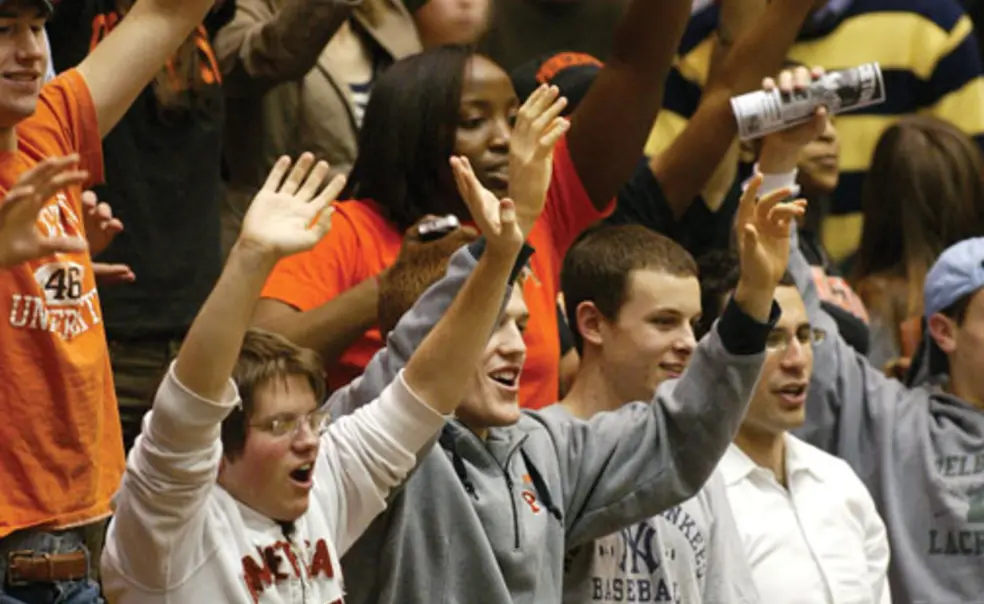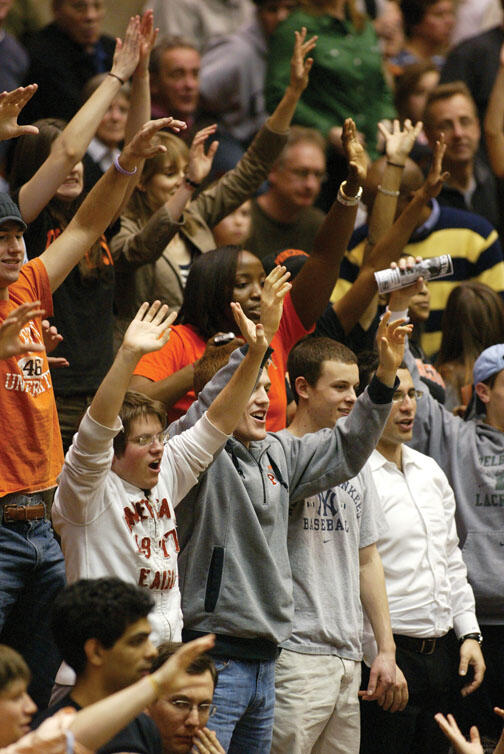The roar of the crowd ... and the motorcycle
The band calls them “the hecklers”: two students who go to as many home men’s basketball games as the plaid-clad band itself does — which is to say, all of them.
They stand, dressed in orange and black, at the front of the student section in Jadwin Gym, armed with a megaphone and a cruel wit. Among the opponents’ offenses that attract their attention are “looking unkempt” and “general lack of talent.”
“It’s fair — it’s all fair,” said Andrew Whitener ’12. “We work with what they provide us,” added a jersey-clad Tom Boggiano ’12.
Boggiano and Whitener, who play varsity baseball and have friends on the basketball team, have attended every home basketball game since their freshman year. Since then, they’ve noticed the bleachers behind them filling up — especially since the men’s team launched its 12-game home winning streak, capped by the Tigers’ final home game against Columbia Feb. 26.
“Our freshman year, we’d be lucky if there were 50 other students in the stands,” Boggiano said. “Now, every time, the student section is filled out.”
Student attendance at basketball games has at least doubled since 2008, said band president Nicole Rafidi ’12.
“We used to be, like, the only fans,” Rafidi said. Now the band leads the students in bleacher-shaking “De-fense” cheers, and “it makes the atmosphere a lot more exciting,” she said.
When Harvard came to Carril Court in early February, students turned out in full force, “like an orange wall,” said Avneesh Sarwate ’14. “You got the impression that the whole crowd was leaning forward the whole game,” Rafidi said.
Princeton won that game 65–61. Most home games have been close,
said Kevin Whitaker ’13, one of the executive editors for sports at The Daily Princetonian, making them all the more compelling. And with the win against Columbia, Princeton came one step closer to winning the Ivy League title.
A simple explanation for the crowds coming to Jadwin is that it’s more fun to watch Princeton win. But at least for the hecklers, it’s not all about winning.
“It’s all about the team,” Boggiano said. “We have a good time — we’d be showing up whether there were other people here or not.”
By Isabel Pike ’11
Twice a week, 16 freshmen get their hands dirty in class. No essays, no problem sets, no exams. Instead, the main assignment of “The Art and Science of Motorcycle Design” is to overhaul a motorcycle.
It’s a 1963 Tiger Cub model from Las Vegas bought on eBay for $650, to be precise. The freshman seminar program, which allows students to work with a professor in a small-group setting, funded the purchase of the bike and supports the course.
Students spend the first hour of class in the Friend Center, where they discuss the more theoretical aspects of motorcycle design with mechanical and aerospace engineering professor Michael Littman, whose research interests include tunable laser design and bio-mimic robotics.
Technical jargon is thrown around the room: retard the spark, kick-backs, position the piston. “You learn on the fly,” said one student.
After an hour, students walk over to the machine shop in the engineering quad. Pulling on old T-shirts and safety goggles, they split into groups with specific assignments: polishing rusty wheels, dismantling the engine, and sand-blasting the bike’s body.
About half the students in the course are engineers; the rest are planning other majors. This balance is key, Littman said. “The seminar is a unique experience for the non-engineers — something they wouldn’t do otherwise,” he said, traces of oil on his fingers.
Farhan Abrol ’14, a prospective physics major who rode a Royal Enfield motorbike in his hometown of New Delhi, said he feels lucky to work in a space usually reserved for engineering seniors. Other freshmen who hear about the course are “a little jealous," he said with a smile.
Littman’s original interest was in old cars — during the summer of 2007, he ran a program that repaired a Model T Ford — but practical reasons led to the use of a motorcycle for the seminar. “Motorcycles fill all the pedagogical goals of the course, as well as being able to fit into the machine shop,” he said.
Will students be able to ride the refurbished motorcycle at the end of the year? “I’m talking with Risk Management,” Littman said.












1 Response
Rick Mott ’73
9 Years AgoPractical knowledge
I thoroughly enjoyed Isabel Pike ’11’s description of the “Art and Science of Motorcycle Design” course (On the Campus, March 23). My most practical electronics education came not from the EE department, where it was quite possible to graduate with no knowledge of which end of the soldering iron heated up, but from two other sources:
First, the legendary WPRB tech team of Dave Boggs and Bruce Almich (both ’72), known by the single word Boggs’n’Almich. Second, a noncredit course offered by the instrumentation technicians of the physics department. I don’t know if that still exists, but I certainly hope so. It was an eye-opening lesson in how the real world works.
The only depressing note was the column’s last line: “I’m talking with Risk Management.” Had there been Risk Management in the 1940s, there probably wouldn’t be a WPRB today.